check engine RENAULT SCENIC 2014 J95 / 3.G Petrol Injection - Sagem3000 Owners Manual
[x] Cancel search | Manufacturer: RENAULT, Model Year: 2014, Model line: SCENIC, Model: RENAULT SCENIC 2014 J95 / 3.GPages: 181
Page 162 of 181
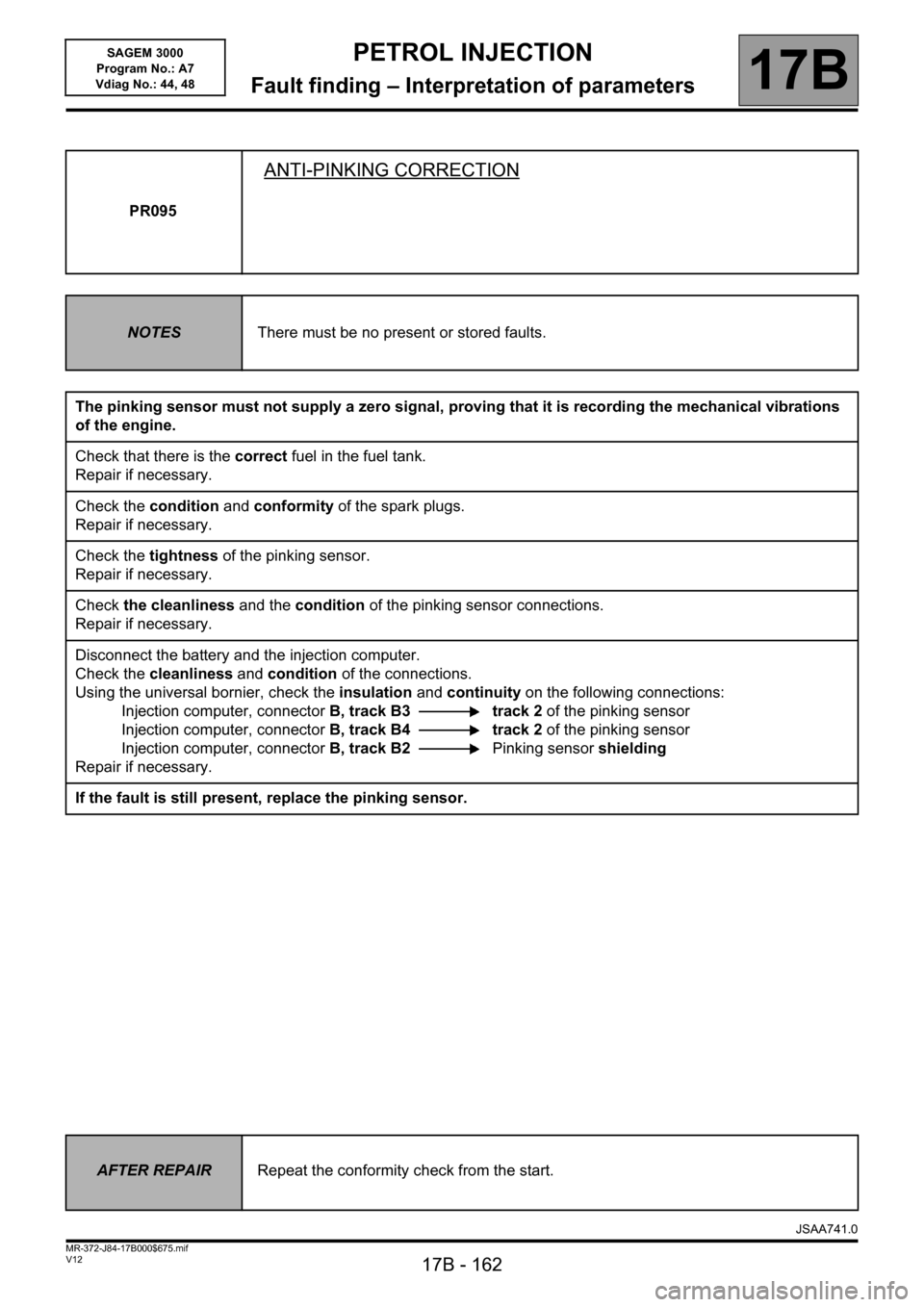
PETROL INJECTION
Fault finding – Interpretation of parameters17B
17B - 162V12 MR-372-J84-17B000$675.mif
SAGEM 3000
Program No.: A7
Vdiag No.: 44, 48
PR095
ANTI-PINKING CORRECTION
NOTESThere must be no present or stored faults.
The pinking sensor must not supply a zero signal, proving that it is recording the mechanical vibrations
of the engine.
Check that there is the correct fuel in the fuel tank.
Repair if necessary.
Check the condition and conformity of the spark plugs.
Repair if necessary.
Check the tightness of the pinking sensor.
Repair if necessary.
Check the cleanliness and the condition of the pinking sensor connections.
Repair if necessary.
Disconnect the battery and the injection computer.
Check the cleanliness and condition of the connections.
Using the universal bornier, check the insulation and continuity on the following connections:
Injection computer, connectorB, track B3 track 2 of the pinking sensor
Injection computer, connectorB, track B4 track 2 of the pinking sensor
Injection computer, connectorB, track B2Pinking sensor shielding
Repair if necessary.
If the fault is still present, replace the pinking sensor.
AFTER REPAIRRepeat the conformity check from the start.
JSAA741.0
Page 164 of 181
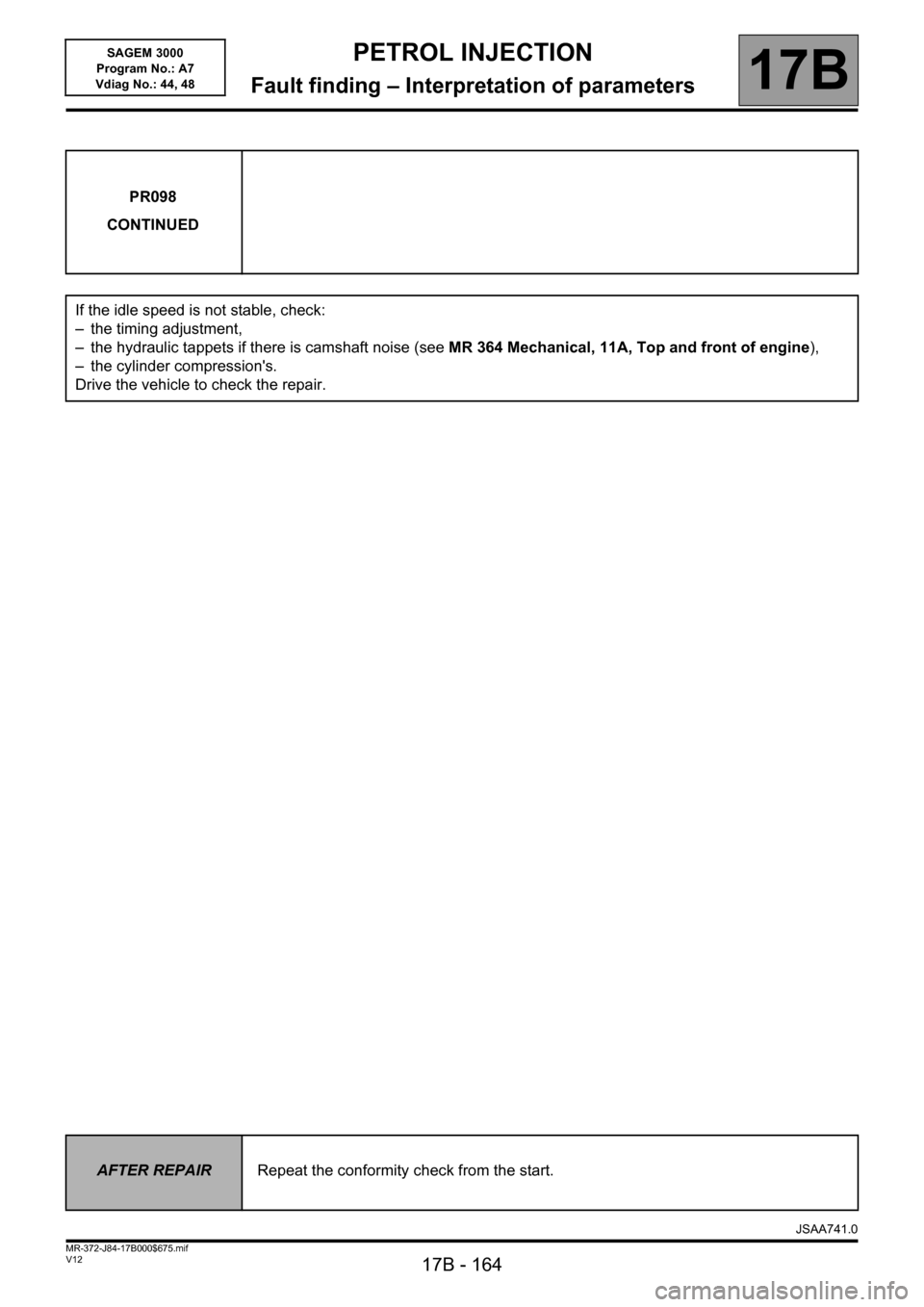
PETROL INJECTION
Fault finding – Interpretation of parameters17B
17B - 164V12 MR-372-J84-17B000$675.mif
SAGEM 3000
Program No.: A7
Vdiag No.: 44, 48
PR098
CONTINUED
If the idle speed is not stable, check:
– the timing adjustment,
– the hydraulic tappets if there is camshaft noise (seeMR 364 Mechanical, 11A, Top and front of engine),
– the cylinder compression's.
Drive the vehicle to check the repair.
AFTER REPAIRRepeat the conformity check from the start.
JSAA741.0
Page 167 of 181
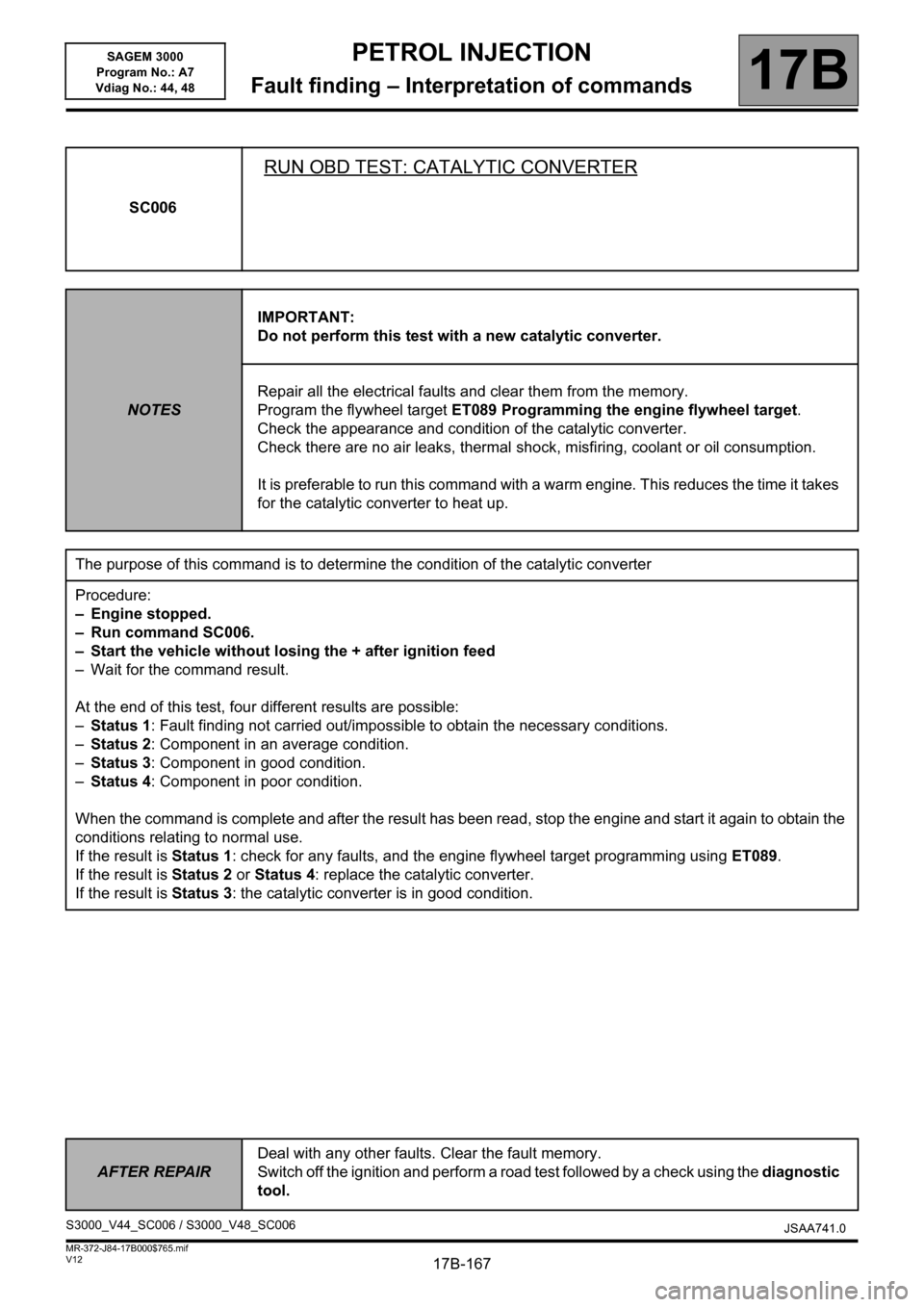
17B-167
AFTER REPAIRDeal with any other faults. Clear the fault memory.
Switch off the ignition and perform a road test followed by a check using the diagnostic
tool.
V12 MR-372-J84-17B000$765.mif
17B
SAGEM 3000
Program No.: A7
Vdiag No.: 44, 48
SC006
RUN OBD TEST: CATALYTIC CONVERTER
NOTESIMPORTANT:
Do not perform this test with a new catalytic converter.
Repair all the electrical faults and clear them from the memory.
Program the flywheel target ET089 Programming the engine flywheel target.
Check the appearance and condition of the catalytic converter.
Check there are no air leaks, thermal shock, misfiring, coolant or oil consumption.
It is preferable to run this command with a warm engine. This reduces the time it takes
for the catalytic converter to heat up.
The purpose of this command is to determine the condition of the catalytic converter
Procedure:
– Engine stopped.
– Run command SC006.
– Start the vehicle without losing the + after ignition feed
– Wait for the command result.
At the end of this test, four different results are possible:
–Status 1: Fault finding not carried out/impossible to obtain the necessary conditions.
–Status 2: Component in an average condition.
–Status 3: Component in good condition.
–Status 4: Component in poor condition.
When the command is complete and after the result has been read, stop the engine and start it again to obtain the
conditions relating to normal use.
If the result is Status 1: check for any faults, and the engine flywheel target programming using ET089.
If the result is Status 2 or Status 4: replace the catalytic converter.
If the result is Status 3: the catalytic converter is in good condition.
S3000_V44_SC006 / S3000_V48_SC006
JSAA741.0
PETROL INJECTION
Fault finding – Interpretation of commands
Page 168 of 181
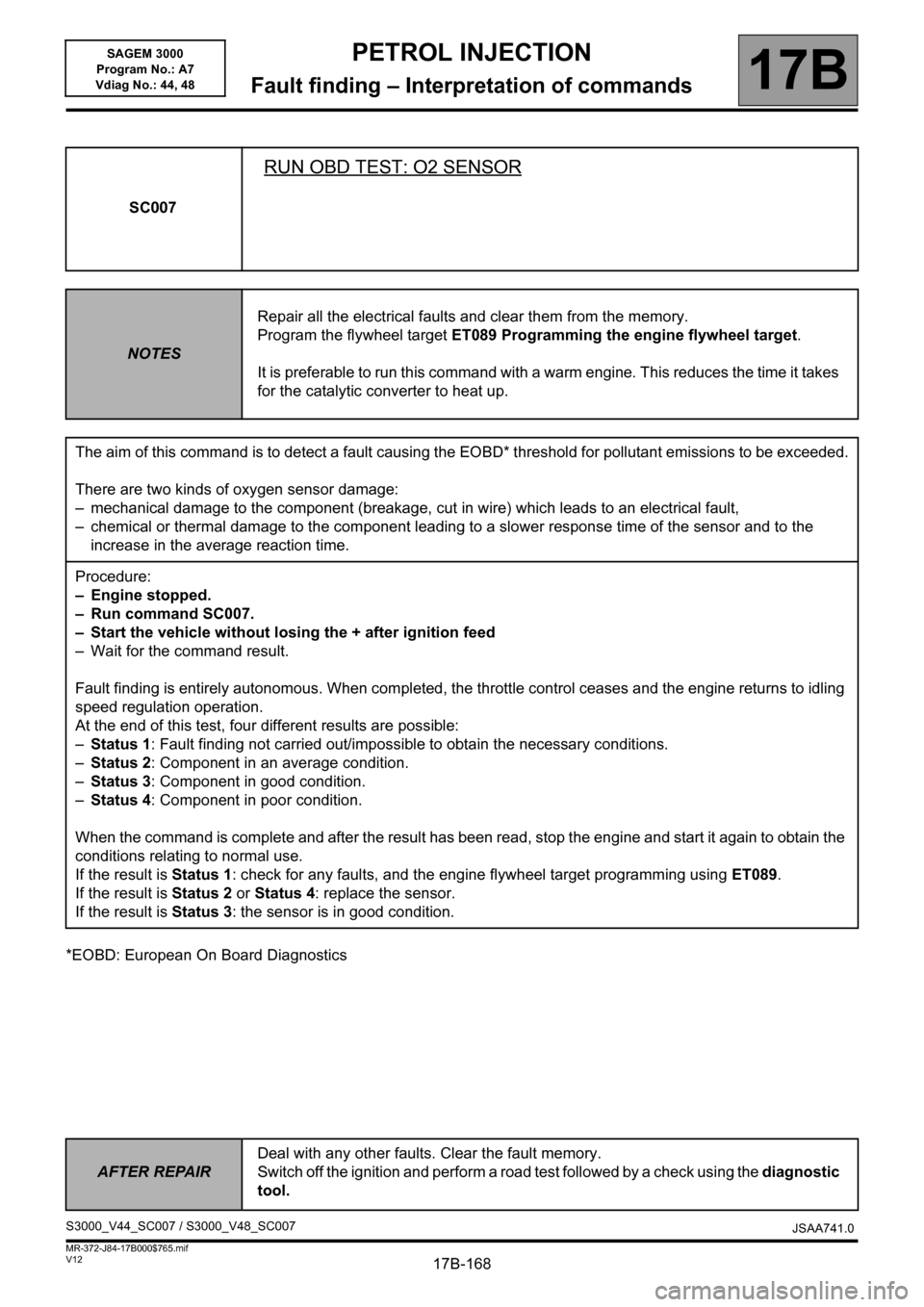
17B-168
AFTER REPAIRDeal with any other faults. Clear the fault memory.
Switch off the ignition and perform a road test followed by a check using the diagnostic
tool.
V12 MR-372-J84-17B000$765.mif
PETROL INJECTION
Fault finding – Interpretation of commands17B
SAGEM 3000
Program No.: A7
Vdiag No.: 44, 48
*EOBD: European On Board DiagnosticsSC007
RUN OBD TEST: O2 SENSOR
NOTESRepair all the electrical faults and clear them from the memory.
Program the flywheel target ET089 Programming the engine flywheel target.
It is preferable to run this command with a warm engine. This reduces the time it takes
for the catalytic converter to heat up.
The aim of this command is to detect a fault causing the EOBD* threshold for pollutant emissions to be exceeded.
There are two kinds of oxygen sensor damage:
– mechanical damage to the component (breakage, cut in wire) which leads to an electrical fault,
– chemical or thermal damage to the component leading to a slower response time of the sensor and to the
increase in the average reaction time.
Procedure:
– Engine stopped.
– Run command SC007.
– Start the vehicle without losing the + after ignition feed
– Wait for the command result.
Fault finding is entirely autonomous. When completed, the throttle control ceases and the engine returns to idling
speed regulation operation.
At the end of this test, four different results are possible:
–Status 1: Fault finding not carried out/impossible to obtain the necessary conditions.
–Status 2: Component in an average condition.
–Status 3: Component in good condition.
–Status 4: Component in poor condition.
When the command is complete and after the result has been read, stop the engine and start it again to obtain the
conditions relating to normal use.
If the result is Status 1: check for any faults, and the engine flywheel target programming using ET089.
If the result is Status 2 or Status 4: replace the sensor.
If the result is Status 3: the sensor is in good condition.
S3000_V44_SC007 / S3000_V48_SC007
JSAA741.0
Page 175 of 181
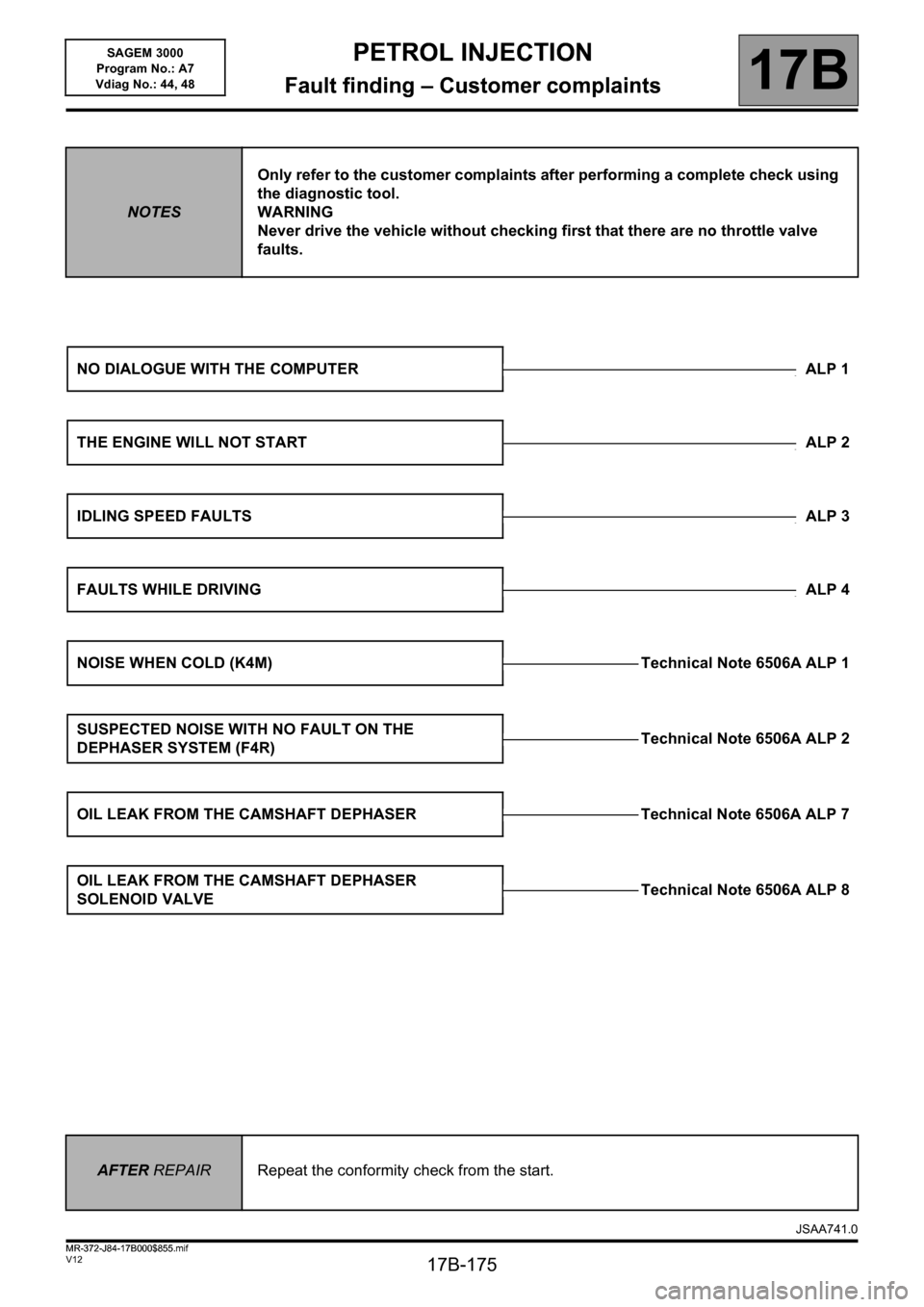
PETROL INJECTION
Fault finding – Customer complaints17B
17B-175V12 MR-372-J84-17B000$855.mif
SAGEM 3000
Program No.: A7
Vdiag No.: 44, 48PETROL INJECTION
Fault finding – Customer complaints
NOTESOnly refer to the customer complaints after performing a complete check using
the diagnostic tool.
WARNING
Never drive the vehicle without checking first that there are no throttle valve
faults.
NO DIALOGUE WITH THE COMPUTER ALP 1
THE ENGINE WILL NOT STARTALP 2
IDLING SPEED FAULTSALP 3
FAULTS WHILE DRIVINGALP 4
NOISE WHEN COLD (K4M) Technical Note 6506A ALP 1
SUSPECTED NOISE WITH NO FAULT ON THE
DEPHASER SYSTEM (F4R)Technical Note 6506A ALP 2
OIL LEAK FROM THE CAMSHAFT DEPHASER Technical Note 6506A ALP 7
OIL LEAK FROM THE CAMSHAFT DEPHASER
SOLENOID VALVETechnical Note 6506A ALP 8
AFTER REPAIRRepeat the conformity check from the start.
JSAA741.0
MR-372-J84-17B000$855.mif
Page 179 of 181
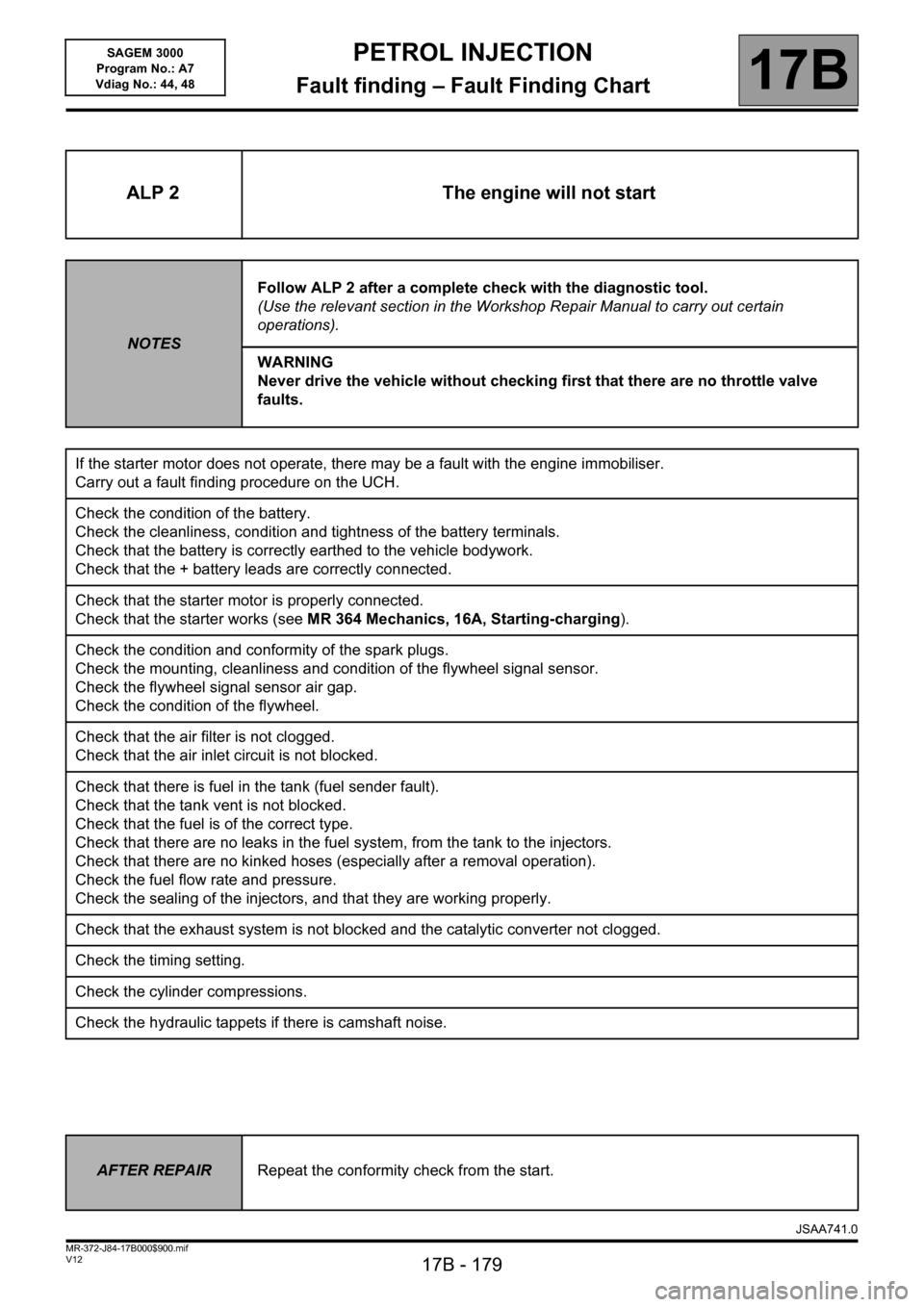
PETROL INJECTION
Fault finding – Fault Finding Chart17B
17B - 179V12 MR-372-J84-17B000$900.mif
SAGEM 3000
Program No.: A7
Vdiag No.: 44, 48
ALP 2 The engine will not start
NOTESFollow ALP 2 after a complete check with the diagnostic tool.
(Use the relevant section in the Workshop Repair Manual to carry out certain
operations).
WARNING
Never drive the vehicle without checking first that there are no throttle valve
faults.
If the starter motor does not operate, there may be a fault with the engine immobiliser.
Carry out a fault finding procedure on the UCH.
Check the condition of the battery.
Check the cleanliness, condition and tightness of the battery terminals.
Check that the battery is correctly earthed to the vehicle bodywork.
Check that the + battery leads are correctly connected.
Check that the starter motor is properly connected.
Check that the starter works (see MR 364 Mechanics, 16A, Starting-charging).
Check the condition and conformity of the spark plugs.
Check the mounting, cleanliness and condition of the flywheel signal sensor.
Check the flywheel signal sensor air gap.
Check the condition of the flywheel.
Check that the air filter is not clogged.
Check that the air inlet circuit is not blocked.
Check that there is fuel in the tank (fuel sender fault).
Check that the tank vent is not blocked.
Check that the fuel is of the correct type.
Check that there are no leaks in the fuel system, from the tank to the injectors.
Check that there are no kinked hoses (especially after a removal operation).
Check the fuel flow rate and pressure.
Check the sealing of the injectors, and that they are working properly.
Check that the exhaust system is not blocked and the catalytic converter not clogged.
Check the timing setting.
Check the cylinder compressions.
Check the hydraulic tappets if there is camshaft noise.
AFTER REPAIRRepeat the conformity check from the start.
JSAA741.0